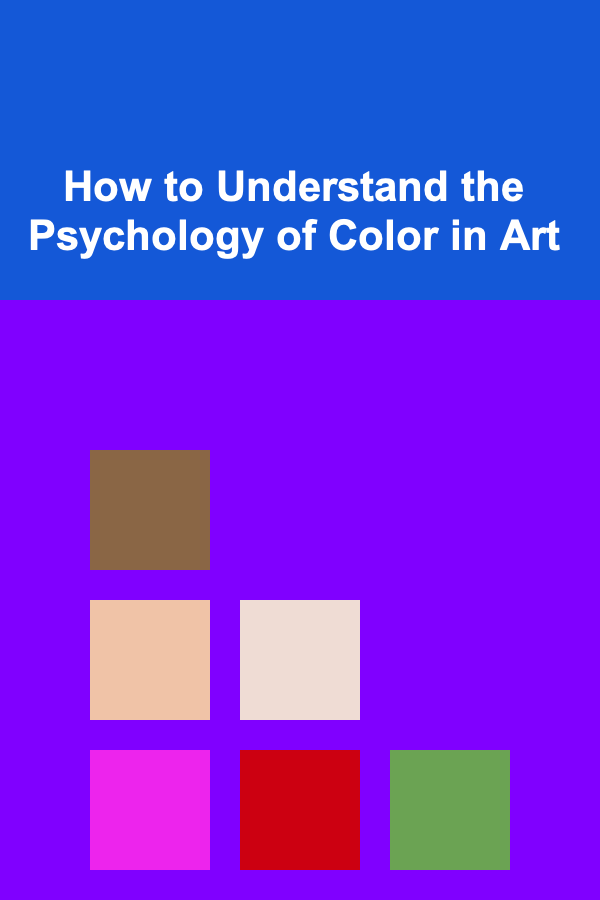
How to Understand the Psychology of Color in Art
ebook include PDF & Audio bundle (Micro Guide)
$12.99$7.99
Limited Time Offer! Order within the next:

The world of color in art is not only one of aesthetic appeal but also a realm rich with deep psychological effects. For centuries, artists have harnessed the power of color to evoke emotions, convey messages, and communicate subtle ideas that transcend language. But what is it about color that triggers such potent psychological responses? Understanding the psychology of color in art can offer profound insights into how we interpret visual stimuli, how artists use color to guide the viewer's experience, and how color can influence our mood and behavior. In this article, we will explore the psychological effects of color in art, how different cultures perceive color, and how artists use this knowledge to create meaningful and emotionally resonant works of art.
The Foundation of Color Psychology
At its core, color psychology examines how colors influence human emotions, behavior, and perception. This field blends art, science, and cultural studies to understand how we interact with the world of color. Colors are not just visual stimuli; they are tied to psychological and emotional responses that shape our perception of everything around us.
Color psychology is a relatively young field, but its roots go back to the early work of scientists and artists. Isaac Newton's discovery of the color spectrum in the 17th century was a pivotal moment in our understanding of light and color. Later, artists such as Wassily Kandinsky and Johannes Itten explored how colors could evoke specific emotional responses. Kandinsky, in particular, believed that colors could evoke spiritual and emotional sensations, and he used this in his abstract paintings.
The Influence of Light
One of the key components of color psychology is light, as colors are, at their core, the result of light wavelengths reflected off objects. The way light interacts with color is critical to understanding how we perceive it. For instance, warm colors like red, yellow, and orange are associated with energy, warmth, and vibrancy because of their longer wavelengths. In contrast, cool colors like blue, green, and purple are linked to calmness and serenity due to their shorter wavelengths.
This relationship between color and light is not only fundamental to how we experience the world visually but also how artists manipulate light and color to create certain effects in their work. By controlling light, shadows, and the use of color contrast, artists can influence the viewer's emotional state or create an atmosphere that aligns with the themes of their piece.
The Psychological Effects of Different Colors
Each color carries with it a set of emotional associations and psychological responses. The understanding of these associations plays a significant role in how artists use color to convey meaning. Below is an exploration of some of the most common colors used in art and the psychological effects they typically evoke:
Red: Energy, Passion, and Danger
Red is often the most intense color in the color spectrum, representing both positive and negative extremes. In art, it is commonly used to evoke strong emotions like love, passion, and excitement. The color red is also linked to power, courage, and strength. It stimulates the senses, creates a sense of urgency, and can increase heart rate and blood pressure, which is why it's often used to grab attention.
However, red can also be associated with danger, anger, and aggression. It's the color of warning signs, fire, and blood. This duality makes red a versatile and powerful tool in an artist's palette, whether they want to create a sense of warmth and vitality or evoke a sense of unease or conflict.
Blue: Calm, Trust, and Sadness
Blue is a color with a calming effect, often associated with tranquility, serenity, and stability. It is no surprise that blue is frequently used in art to create a sense of peace or to evoke emotional reflection. In works of art, blue is often used to depict the sky, water, or other natural elements that are inherently linked with calmness and vastness.
Psychologically, blue is also linked to trust and reliability, which is why it's commonly used in logos and branding for businesses. On the other hand, blue can also evoke sadness, loneliness, or melancholy, which is why it has been used in various artistic movements, such as the "Blues" in music and the use of blue tones in paintings by artists like Picasso during his Blue Period.
Yellow: Optimism, Creativity, and Caution
Yellow is the color most associated with optimism, happiness, and energy. It stimulates the mind and encourages creativity. In art, yellow can be used to represent sunlight, warmth, and hope. It is a color that draws attention and makes a statement, which is why it's often used as an accent color or in bold visual compositions.
However, yellow can also carry a sense of caution or anxiety. It is the color of warning signs and traffic signals, often signaling the need for attention or alertness. In some contexts, too much yellow can create feelings of agitation or unease, as it can be overwhelming to the senses if overused.
Green: Balance, Growth, and Envy
Green is the color of nature, growth, and renewal. It represents balance and harmony, evoking feelings of calmness and connection to the natural world. In art, green is often used to depict landscapes, forests, and foliage, symbolizing life, fertility, and the cycles of nature.
On a psychological level, green has a soothing effect, and it can be used in art to create a sense of relaxation or balance. However, green can also have negative connotations, such as envy, jealousy, and inexperience. The term "green with envy" reflects this more complex emotional association, and artists may use different shades of green to evoke a range of emotions, from harmony to jealousy.
Purple: Luxury, Spirituality, and Mystery
Purple is often regarded as a luxurious, regal color, historically associated with royalty and nobility due to the rarity and cost of purple dyes in ancient times. It symbolizes wealth, power, and status. In art, purple is frequently used to evoke a sense of grandeur and sophistication.
Beyond its associations with material wealth, purple is also linked to spirituality and creativity. It has been used throughout history to represent mysticism and the unknown, making it a common color in artworks that explore themes of transcendence, the divine, or the supernatural. Purple can also provoke a sense of mystery and intrigue, inviting the viewer to delve deeper into the work.
Black: Sophistication, Death, and Mystery
Black is often considered a powerful and sophisticated color. In art, it can be used to create dramatic contrasts and add depth to compositions. Black can evoke feelings of elegance, formality, and timelessness. It is the color of shadows and darkness, symbolizing mystery, the unknown, and the unseen.
However, black is also associated with death, mourning, and negativity. It can represent emptiness or void, creating feelings of isolation or despair. In works of art that deal with themes of loss, tragedy, or existential questioning, black plays a crucial role in setting the tone and evoking deep emotional responses from the viewer.
White: Purity, Innocence, and Simplicity
White is often seen as the color of purity, innocence, and cleanliness. It represents clarity, simplicity, and a fresh start. In art, white is frequently used to create a sense of space or to highlight other colors. It is the color of light and is often associated with new beginnings or a blank canvas.
However, white can also evoke feelings of emptiness or sterility. In some contexts, it can symbolize isolation or coldness. The use of white in minimalist art, for example, can emphasize the absence of detail or create a stark contrast with other more vivid colors, making the viewer reflect on the importance of negative space.
Cultural Perceptions of Color
While the psychological effects of color are universal to some extent, it's essential to recognize that different cultures can have distinct interpretations of color. Cultural context plays a significant role in how colors are perceived and used in art.
The West vs. the East
In Western cultures, for instance, the color white is often associated with purity and weddings, whereas in many Eastern cultures, particularly in China and Japan, white is linked to mourning and death. Similarly, red is a color of luck and celebration in China, but it can signify danger or warning in Western contexts.
This difference in cultural perceptions is crucial for artists working in a globalized world, where an artwork may be viewed by audiences from various cultural backgrounds. Artists must be aware of how their color choices might be interpreted by different viewers to ensure their intended message is communicated effectively.
The Artist's Intent and Color Use
Artists use color intentionally to achieve specific effects, guide the viewer's eye, and communicate meaning. Understanding color psychology is crucial for artists in creating compelling visual narratives. Whether an artist is working with traditional mediums like oil paints or contemporary forms like digital art, color plays an essential role in shaping the viewer's experience.
Artists may use warm or cool colors to convey different moods, select contrasting colors to highlight particular elements, or use subtle tonal shifts to create depth and movement within a piece. Moreover, the juxtaposition of colors can influence the emotional tone of the artwork, with complementary colors (e.g., red and green) creating vibrant tension, and analogous colors (e.g., blue and green) offering harmonious and serene effects.
Ultimately, the psychology of color allows artists to create multi-layered works that speak to the viewer on a deeper psychological and emotional level. By understanding how colors evoke certain responses, artists can use this knowledge to convey complex themes and provoke thought and reflection.
Conclusion
The psychology of color in art is a powerful tool that artists use to evoke emotions, communicate ideas, and create visual experiences that resonate with viewers. By understanding the psychological effects of different colors, artists can manipulate color to influence the emotional response of their audience, guiding them through the narrative of the artwork.
The relationship between color and psychology is complex and multifaceted, and it is shaped by both biological responses and cultural perceptions. Whether used to convey warmth, create tension, or evoke feelings of tranquility, color serves as a key medium through which artists explore the human condition.
As viewers, being mindful of the psychological impact of color allows us to better appreciate the intentional choices artists make and to engage more deeply with the artwork. Color, in all its complexity, is an integral part of the artistic experience, providing a bridge between the artist's intentions and the viewer's emotional and psychological response.

How To Break the Habit of Complaining
Read More
How to Make Your Home Look Bigger with Clever Lighting Techniques
Read More
How to Organize Your Digital Art Portfolio for Showcase
Read More
The Art of Negotiation: How to Stand Out by Getting What You Want
Read More
How To Improve Your Physical Well-being for Overall Health
Read More
How To Find Books That Spark Your Imagination
Read MoreOther Products

How To Break the Habit of Complaining
Read More
How to Make Your Home Look Bigger with Clever Lighting Techniques
Read More
How to Organize Your Digital Art Portfolio for Showcase
Read More
The Art of Negotiation: How to Stand Out by Getting What You Want
Read More
How To Improve Your Physical Well-being for Overall Health
Read More